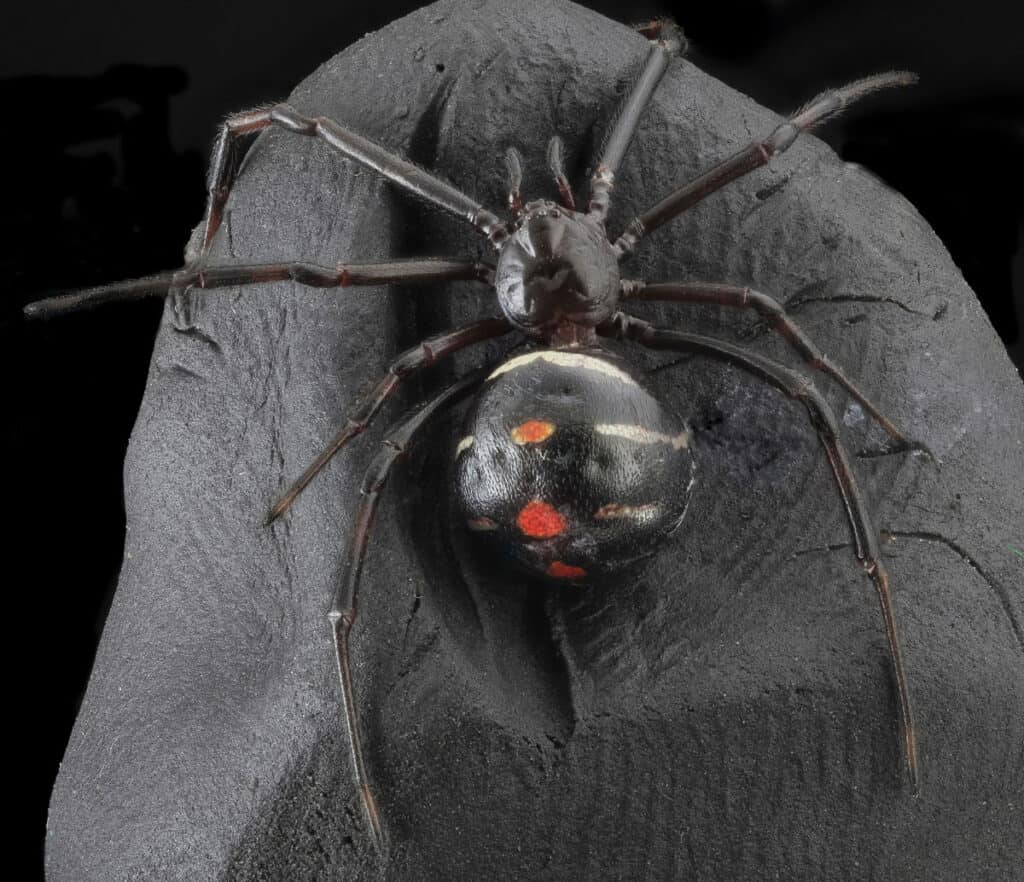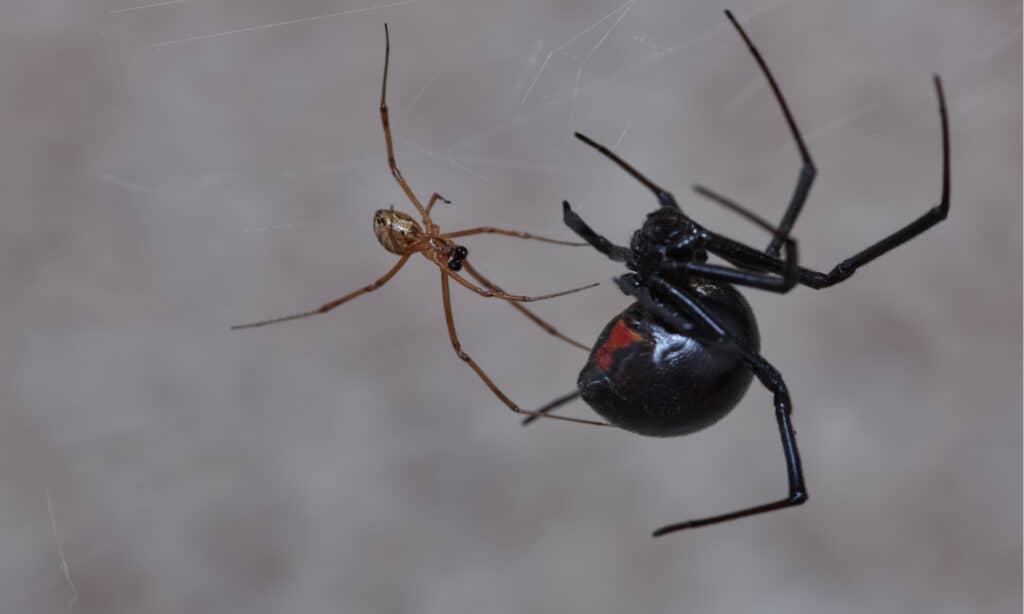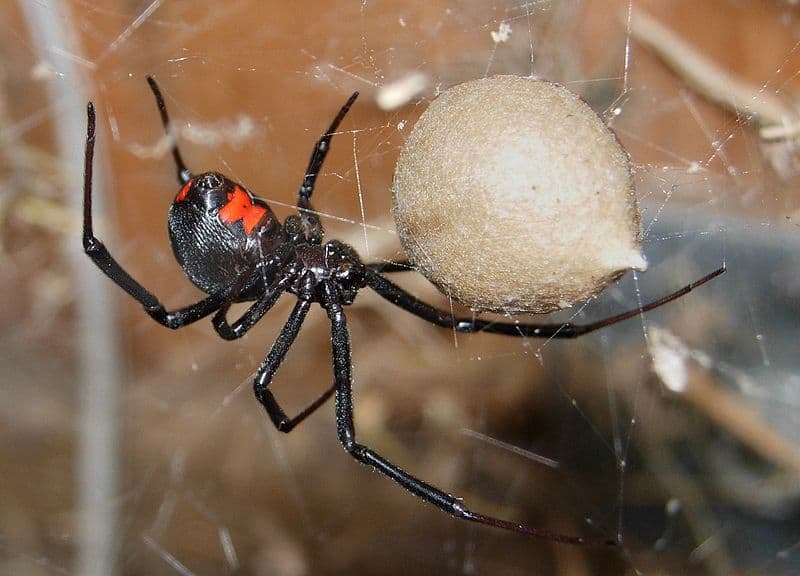Spiders make many people uneasy. The way these arachnids skitter along the ground and seemingly appear out of nowhere in homes is enough to set anyone on edge. That’s not even considering the danger that some of them pose, like black widows. These venomous spiders can deliver a medically significant bite that impacts the victim’s nervous system. Take a look at this black widow size comparison to learn how big these spiders get so you can learn to recognize them!
What Is a Black Widow?

Several people are hospitalized each year due to bites from northern black widow spiders
©Porco_Rosso/Shutterstock.com
The name ‘black widow’ does not refer to a single species of spider. Instead, the name is applied to spiders from the Latrodectus genus. However, even some spiders in that group are called black widows and brown widows depending on their appearance.
These spiders live throughout the world, including places as far-flung as South America and South Africa!
For the most part, the term black widow is widely applied to three different species within this genus. At least, that’s the case in North America. To narrow our focus on this genus, this black widow size comparison will focus on three of the most commonly encountered species in North America. They include:
- Southern black widow (Latrodectus mactans)
- Northern black widow (Latrodectus variolus)
- Western black widow (Latrodectus hesperus)
These three species occupy different parts of North America, but some of their ranges overlap. Specifically, the western and southern black widows and the northern and southern black widows share a range in some places.
Black Widow Size Comparison

| Species | Female Size | Male Size |
|---|---|---|
| Southern Black Widow | Female: 0.31 to 0.5 inches in body length, about 1 to 1.37 inches long including legs. | Male: 0.15 to 0.23 inches in body length, about 0.7 inches long including legs. |
| Northern Black Widow | Female: about 0.5 inches in body length, about 1.5 inches long including legs. | Male: 0.11 to 0.4 inches in body length, about 0.51 inches including legs. |
| Western Black Widow | Female: 0.25 to 0.33 inches long, about 1.5 inches long including legs. | Male: 0.13 to 0.25 in body length, about 0.5 inches with legs. |
Black widows range in total size from about 0.5 inches to 1.5 inches in total length on average when including both male and female spiders. These black widows range in size based on both their species and sex.
The majority of spiders in the Latrodectus genus exhibit sexual size dimorphism that favors the females being larger than the males. That is why the males on this list are much smaller than the female black widows.
The females tend to be many times larger than the males. Also, the female northern and western black widows tend to reach greater total lengths than the southern black widow according to available scholarly resources. However, the differences in total length are small since they can all grow to about 1.5 inches long.
Still, the male southern black widows seem to have the lowest body length but the greatest overall length including their legs. All told, these spiders are not very large even though they have a deadly reputation.
Comparing Black Widow Sizes to Household Items

The average skinny tie clip is about the same length as a female black widow spider at its greatest length.
©A.A. Smirnov/Shutterstock.com
Knowing that the average female black spider is about 1.5 inches is helpful. However, that measurement requires some context to help people understand the true size of the spider. Take a look at some items that measure about the same length as an adult female black widow:
- A single Airpod
- A skinny tie clip
- A safety pin
These items share the same overall length as the average female black widow at the larger range of its size. However, they have bulbous abdomens along with their famous red or orange markings on their ventral side. Meanwhile, male black widow spiders have bodes that are about the size of a standard staple and a total length about the diameter of a nickel.
Although they are smaller and less noticeable than females, male widow spiders are not considered dangerous. While they’re harder to spot, they are not known for biting humans.
The Largest Black Widow Ever Recorded

The largest black widow spider is a matter of contention, but it could be a new species from South
Africa
.
©lighTTrace Studio/Shutterstock.com
Many black widow species top out at about 1.5 inches long. That makes it difficult to discern which is the largest black widow species. Yet, a newly discovered spider, the Phinda button spider, could be the largest black widow ever recorded.
Scientists first described the Phinda button spider (Latrodectus umbukwane) in 2019. While some resources list the female’s total size as about 0.43 inches, other sources claim that the species measures up to 1.2 inches in body length.
The more likely body size is 0.43 inches due to the measure coming from the Agricultural Research Council in South Africa. Still, accurate measurements including the legs of the spider have not yet been released. Given the size of the spider in online videos, the spider seems to be over 1 inch long.
So, the title of the largest black widow ever recorded is not easily accessible or widespread information. That may have something to do with the fact that most people are not keen to catch and handle black widows.
Places You Are Most Likely to Encounter a Black Widow

Black widows prefer to stay in places where they are safe and hidden.
©Chuck Evans(mcevan)”./ CC BY 2.5, via Wikimedia Commons – License
Black widows rarely, if ever, build their nests inside in places where humans are common. That is not to say they cannot and will not get into a house, though. After all, they prefer places where they can spin webs and capture food. Sometimes, their need for prey and a safe environment can bring them into contact with humans.
That being said, black widows are most likely to build their webs outdoors near plants in wooded areas such as temperate forests. These spiders can live between rocks, near foundations, and in hollow tree stumps. Black widows also prefer to hunker down in piles of wood. They’ll also build their webs near some human structures that do not get much traffic, like garages, outhouses, the underside of wooden decks, and basements.
Keep in mind, though, they are not looking to harm humans. Black widows are most likely to bite a person when they’re protecting the eggs in their nest or if they’re pressed against a person. Discomfort from a venomous black widow bite is common, but fatalities are exceptionally rare.
Looking at a black widow size comparison, it’s clear that the species in the U.S. are all about the same size. Of course, the females outgrow the males by a great deal, but the largest black widows are about the size of a paper clip. New information about the Phinda button spider could result in that spider being named the largest black widow in existence. If that happens, we’ll update this article!
The photo featured at the top of this post is © Jay Ondreicka/Shutterstock.com
Thank you for reading! Have some feedback for us? Contact the AZ Animals editorial team.







